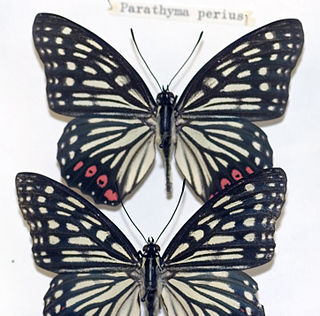
Hestina assimilis, the red ring skirt, is a species of butterfly in the family Nymphalidae found in Asia. It is generally of large size. There are several subspecies: H. a. assimilis, H. a. formosana (Moore, H. a. shirakii, and H. a. f. nigrivena
Parasiccia is a genus of moth in the subfamily Arctiinae.
Gymnastes is a genus of crane fly in the family Limoniidae.
Azpeytia is a genus of hoverfly. Larvae of one species Azpeytia shirakii is known to live in the corms and stems of an orchid Gastrodia elata.

Parasa shirakii is a moth of the family Limacodidae. It is found in Taiwan.
Amata shirakii is a moth of the subfamily Arctiinae. It was described by Jinhaku Sonan in 1941. It is found in Taiwan.
Parasiccia chinensis is a moth of the subfamily Arctiinae. It was described by Franz Daniel in 1951. It is found in Zhejiang, China.

Parasiccia dentata is a moth of the subfamily Arctiinae. It was described by Wileman in 1911. It is found in Taiwan.

Parasiccia fuscipennis is a moth of the subfamily Arctiinae. It was described by George Hampson in 1914. It is found in Taiwan.
Parasiccia nebulosa is a moth of the subfamily Arctiinae. It was described by Wileman in 1914. It is found in Taiwan.
Parasiccia nocturna is a moth of the subfamily Arctiinae. It was described by George Hampson in 1900. It is found in Assam, India.
Parasiccia ochrorubens is a moth of the subfamily Arctiinae. It was described by Mabille in 1900. It is found in Madagascar.
Parasiccia perirrorata is a moth of the subfamily Arctiinae. It was described by George Hampson in 1903. It is found in China.
Parasiccia punctilinea is a moth of the subfamily Arctiinae. It was described by Wileman in 1911. It is found in Taiwan.
Neacanista is a genus of beetles in the family Cerambycidae, containing the following species:
Psidopala is a genus of moths belonging to the subfamily Thyatirinae.

Psidopala shirakii is a moth in the family Drepanidae. It was described by Shōnen Matsumura in 1931. It is found in Taiwan.
Oberea shirakii is a species of beetle in the family Cerambycidae. It was described by Masao Hayashi in 1963.
Pyrgocorypha is a genus of coneheads in the family Tettigoniidae. There are about 16 described species in Pyrgocorypha.
Shirakiacris is an Asian genus of grasshoppers in the subfamily Eyprepocnemidinae and the tribe Eyprepocnemidini. Its recorded distribution includes: southern and eastern China, Korea, Japan and Vietnam.






